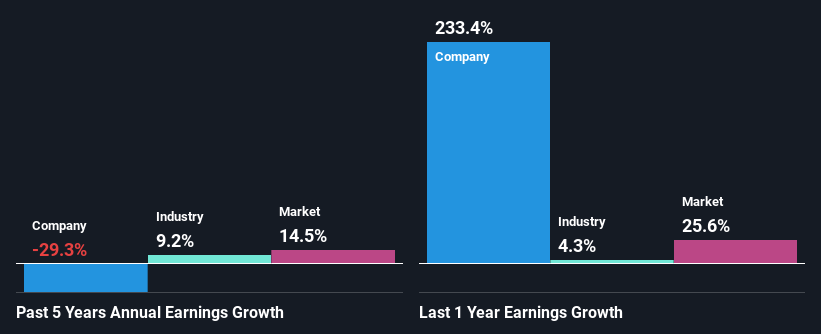Does Blackmores Limited's (ASX:BKL) Weak Fundamentals Mean That The Stock Could Move In The Opposite Direction?
Blackmores' (ASX:BKL) stock up by 5.9% over the past three months. Given that the markets usually pay for the long-term financial health of a company, we wonder if the current momentum in the share price will keep up, given that the company's financials don't look very promising. Particularly, we will be paying attention to Blackmores' ROE today.
Return on Equity or ROE is a test of how effectively a company is growing its value and managing investors’ money. Simply put, it is used to assess the profitability of a company in relation to its equity capital.
See our latest analysis for Blackmores
How Is ROE Calculated?
Return on equity can be calculated by using the formula:
Return on Equity = Net Profit (from continuing operations) ÷ Shareholders' Equity
So, based on the above formula, the ROE for Blackmores is:
9.5% = AU$38m ÷ AU$399m (Based on the trailing twelve months to December 2021).
The 'return' refers to a company's earnings over the last year. So, this means that for every A$1 of its shareholder's investments, the company generates a profit of A$0.10.
Why Is ROE Important For Earnings Growth?
Thus far, we have learned that ROE measures how efficiently a company is generating its profits. Based on how much of its profits the company chooses to reinvest or "retain", we are then able to evaluate a company's future ability to generate profits. Assuming all else is equal, companies that have both a higher return on equity and higher profit retention are usually the ones that have a higher growth rate when compared to companies that don't have the same features.
A Side By Side comparison of Blackmores' Earnings Growth And 9.5% ROE
When you first look at it, Blackmores' ROE doesn't look that attractive. However, its ROE is similar to the industry average of 11%, so we won't completely dismiss the company. Having said that, Blackmores' five year net income decline rate was 29%. Bear in mind, the company does have a slightly low ROE. So that's what might be causing earnings growth to shrink.
As a next step, we compared Blackmores' performance with the industry and found thatBlackmores' performance is depressing even when compared with the industry, which has shrunk its earnings at a rate of 11% in the same period, which is a slower than the company.
The basis for attaching value to a company is, to a great extent, tied to its earnings growth. What investors need to determine next is if the expected earnings growth, or the lack of it, is already built into the share price. This then helps them determine if the stock is placed for a bright or bleak future. If you're wondering about Blackmores''s valuation, check out this gauge of its price-to-earnings ratio, as compared to its industry.
Is Blackmores Making Efficient Use Of Its Profits?
Blackmores' declining earnings is not surprising given how the company is spending most of its profits in paying dividends, judging by its three-year median payout ratio of 62% (or a retention ratio of 38%). With only very little left to reinvest into the business, growth in earnings is far from likely.
In addition, Blackmores has been paying dividends over a period of at least ten years suggesting that keeping up dividend payments is way more important to the management even if it comes at the cost of business growth. Our latest analyst data shows that the future payout ratio of the company over the next three years is expected to be approximately 54%. Regardless, the future ROE for Blackmores is predicted to rise to 15% despite there being not much change expected in its payout ratio.
Conclusion
In total, we would have a hard think before deciding on any investment action concerning Blackmores. Because the company is not reinvesting much into the business, and given the low ROE, it's not surprising to see the lack or absence of growth in its earnings. That being so, the latest industry analyst forecasts show that the analysts are expecting to see a huge improvement in the company's earnings growth rate. Are these analysts expectations based on the broad expectations for the industry, or on the company's fundamentals? Click here to be taken to our analyst's forecasts page for the company.
Have feedback on this article? Concerned about the content? Get in touch with us directly. Alternatively, email editorial-team (at) simplywallst.com.
This article by Simply Wall St is general in nature. We provide commentary based on historical data and analyst forecasts only using an unbiased methodology and our articles are not intended to be financial advice. It does not constitute a recommendation to buy or sell any stock, and does not take account of your objectives, or your financial situation. We aim to bring you long-term focused analysis driven by fundamental data. Note that our analysis may not factor in the latest price-sensitive company announcements or qualitative material. Simply Wall St has no position in any stocks mentioned.
Join A Paid User Research Session
You’ll receive a US$30 Amazon Gift card for 1 hour of your time while helping us build better investing tools for the individual investors like yourself. Sign up here

 Yahoo Finance
Yahoo Finance 
